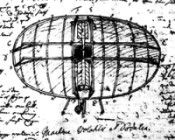- Joined
- Aug 18, 2002
- Messages
- 19,406
Just reading through Susan Clancy's Abducted and she claims to have read every acocunt of alien abduction published and seen nearly every film with aliens in (pos. aliens kidnapping people) and she has a section about the earliest contact with aliens so I thought I'd throw in what she says and see if anyone knows of any other examples.
This is just for examing the earliest contact claims - if you are interested there is a thread on Clancy and her work here:
www.forteantimes.com/forum/viewtopic.php?t=23760
------------
Although life on alien planets has been discussed as far back as the Greeks actual contact with these inhabitants (CE3s) didn't come until much later:
Emanuel Swedenborg wrote about communications with people form other worlds (although he was going a bit nuts at the time) in his Arcana coelestia (1749-1756):
http://en.wikipedia.org/wiki/Emanuel_Swedenborg
After that we have odd encounters during the airship flap with 2 accounts from 1897:
A farmer in Missouri met a stunningly beautiful alien woman
A West Virginian saw 8 Martians emerge from an illimunuated craft. They were 11-12 feet tall and drank air and took small pills (I assume they weere looking for an early tournament game with the Harlem Globe Trotters but got their timing wrong),
Then in 1953 Adamski published his book about chats with aliens in the desert.
---------------
These are all your close encounters of the third kind (CE3s) but according to her info abductions (CE4s) didn't happen until later.
The first encounters seem to be in fiction. Firts Invaders from Mars (1953), This Island Earth (1955) and in the early sixties The Outer Limits. The dealt with abduction but also hybridisation: The Children of Spider Country, Second Chance and Bellaro Shield.
The first major abduction case was the Hills which came to light in 1964.
However, she doesn't mention Antonio Villas Boas who claimed to have been kidnapped in 1957 and didn't need hypnosis to recover his memories. This article also mentions a number of accounts of (mainly) men being kidnapped for space nookie:
www.forteantimes.com/articles/121_aliensex.shtml
She also doesn't look further back to the pulp fiction of the 1930s:
www.skepticfiles.org/ufo2/unpredis.htm
and possibly even some similarities with the Shaver Mystery - all mentioned here:
http://en.wikipedia.org/wiki/Abduction_ ... on#History
It is interesting to see the change from the accounts of space nookie with nearly human women in the fifties to the nasty intrusions of the mid-sixties.
Anyone got any other info?
--------------
CE Wikipedia entry (which has us as an external link):
http://en.wikipedia.org/wiki/Close_encounter
This is just for examing the earliest contact claims - if you are interested there is a thread on Clancy and her work here:
www.forteantimes.com/forum/viewtopic.php?t=23760
------------
Although life on alien planets has been discussed as far back as the Greeks actual contact with these inhabitants (CE3s) didn't come until much later:
Emanuel Swedenborg wrote about communications with people form other worlds (although he was going a bit nuts at the time) in his Arcana coelestia (1749-1756):
http://en.wikipedia.org/wiki/Emanuel_Swedenborg
After that we have odd encounters during the airship flap with 2 accounts from 1897:
A farmer in Missouri met a stunningly beautiful alien woman
A West Virginian saw 8 Martians emerge from an illimunuated craft. They were 11-12 feet tall and drank air and took small pills (I assume they weere looking for an early tournament game with the Harlem Globe Trotters but got their timing wrong),
Then in 1953 Adamski published his book about chats with aliens in the desert.
---------------
These are all your close encounters of the third kind (CE3s) but according to her info abductions (CE4s) didn't happen until later.
The first encounters seem to be in fiction. Firts Invaders from Mars (1953), This Island Earth (1955) and in the early sixties The Outer Limits. The dealt with abduction but also hybridisation: The Children of Spider Country, Second Chance and Bellaro Shield.
The first major abduction case was the Hills which came to light in 1964.
However, she doesn't mention Antonio Villas Boas who claimed to have been kidnapped in 1957 and didn't need hypnosis to recover his memories. This article also mentions a number of accounts of (mainly) men being kidnapped for space nookie:
www.forteantimes.com/articles/121_aliensex.shtml
She also doesn't look further back to the pulp fiction of the 1930s:
www.skepticfiles.org/ufo2/unpredis.htm
and possibly even some similarities with the Shaver Mystery - all mentioned here:
http://en.wikipedia.org/wiki/Abduction_ ... on#History
It is interesting to see the change from the accounts of space nookie with nearly human women in the fifties to the nasty intrusions of the mid-sixties.
Anyone got any other info?
--------------
CE Wikipedia entry (which has us as an external link):
http://en.wikipedia.org/wiki/Close_encounter



